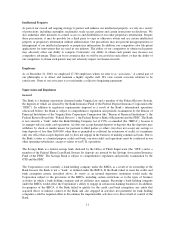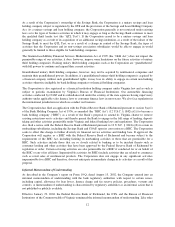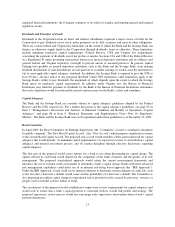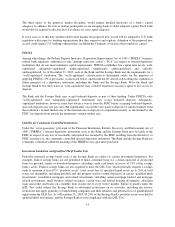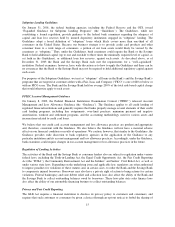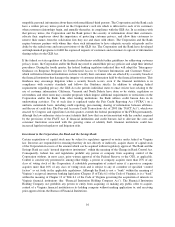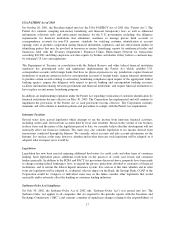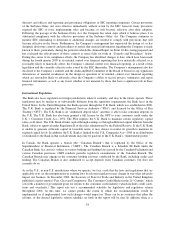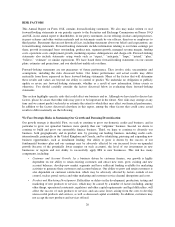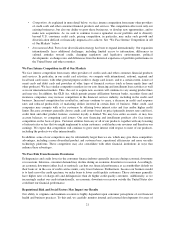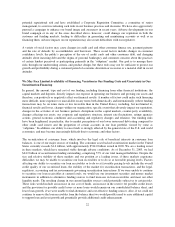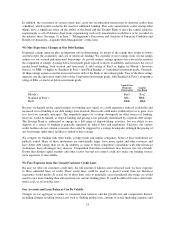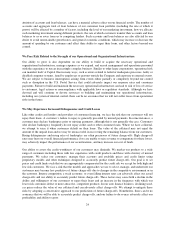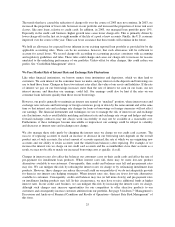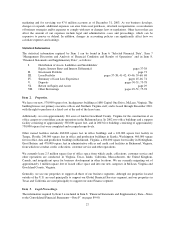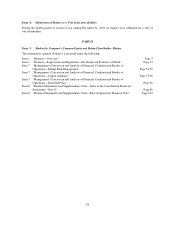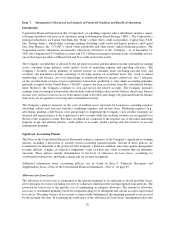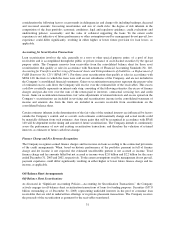Capital One 2003 Annual Report Download - page 39
Download and view the complete annual report
Please find page 39 of the 2003 Capital One annual report below. You can navigate through the pages in the report by either clicking on the pages listed below, or by using the keyword search tool below to find specific information within the annual report.•Competition. As explained in more detail below, we face intense competition from many other providers
of credit cards and other consumer financial products and services. The competition affects not only our
existing businesses, but also our ability to grow these businesses, to develop new opportunities, and to
make new acquisitions. As we seek to continue to move upmarket in our portfolio and to diversify
beyond U.S. consumer credit cards, pricing competition, in particular, may make such growth and
diversification difficult or financially impractical to achieve. See “We Face Intense Competition in All
of Our Markets” below.
•International Risk. Part of our diversification strategy has been to expand internationally. Our expansion
internationally faces additional challenges, including limited access to information, differences in
cultural attitudes toward credit, changing regulatory and legislative environments, political
developments, exchange rates and differences from the historical experience of portfolio performance in
the United States and other countries.
We Face Intense Competition in All of Our Markets
We face intense competition from many other providers of credit cards and other consumer financial products
and services. In particular, in our credit card activities, we compete with international, national, regional and
local bank card issuers, with other general purpose credit or charge card issuers, and to a certain extent, issuers of
smart cards and debit cards and providers of other types of financial services (such as home equity lines and
other products). We face similar competitive markets in our auto financing and installment loan activities as well
as in our international markets. Thus, the cost to acquire new accounts will continue to vary among product lines
and may rise. In addition, the GLB Act, which permits greater affiliations between banks, securities firms and
insurance companies, may increase competition in the financial services industry, including in the credit card
business. Increased competition has resulted in, and may continue to cause, a decrease in credit card response
rates and reduced productivity of marketing dollars invested in certain lines of business. Other credit card
companies may compete with us for customers by offering lower interest rates and fees and/or higher credit
limits. Because customers generally choose credit card issuers based on price (primarily interest rates and fees),
credit limit and other product features, customer loyalty is limited. We may lose entire accounts, or may lose
account balances, to competing card issuers. Our auto financing and installment products also face intense
competition on the basis of price. Customer attrition from any or all of our products, together with any lowering
of interest rates or fees that we might implement to retain customers, could reduce our revenues and therefore our
earnings. We expect that competition will continue to grow more intense with respect to most of our products,
including the products we offer internationally.
In addition, some of our competitors may be substantially larger than we are, which may give those competitors
advantages, including a more diversified product and customer base, operational efficiencies and more versatile
technology platforms. These competitors may also consolidate with other financial institutions in ways that
enhance these advantages.
We Face Risk From Economic Downturns
Delinquencies and credit losses in the consumer finance industry generally increase during economic downturns
or recessions. Likewise, consumer demand may decline during an economic downturn or recession. Accordingly,
an economic downturn (either local or national), can hurt our financial performance as accountholders default on
their loans or, in the case of credit card accounts, carry lower balances. Furthermore, because our business model
is to lend across the credit spectrum, we make loans to lower credit quality customers. These customers generally
have higher rates of charge-offs and delinquencies than do higher credit quality customers. Additionally, as we
increasingly market our cards internationally, an economic downturn or recession outside the United States also
could hurt our financial performance.
Reputational Risk and Social Factors May Impact our Results
Our ability to originate and maintain accounts is highly dependent upon consumer perceptions of our financial
health and business practices. To this end, we carefully monitor internal and external developments for areas of
21


